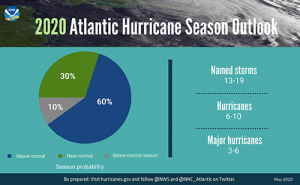We’re now in the prime of hurricane season. Living in Florida, preparing for possible destructive storms is just part of life. So, it’s important to plan and take steps to protect ourselves, our homes and our landscapes.
This time of year, we need to have a contingency plan against powerful winds and flooding rains. Ornamental trees and shrubs are especially vulnerable.
An important protective measure is to stake and attach guide wires to any recently planted (within 12 months) trees or large shrubs. Although root systems may very well be established, the young roots may not yet have anchoring capacity and could snap under strong winds. Stakes should be 2’-3’ in length. Using three or four stakes and driving them away from the plant at a 45-degree angle for 18” or more should be sufficient. So, how far should the stakes be from a tree? A good practice is to drive the stake approximately the same distance from the base of the tree as the height above ground from where guide wires will be attached.
Studies have shown that 20% of storm damage is caused by trees during hurricane or tropical storm events. Just a cubic foot of pine branch weighs 52 lbs. A branch ten feet in length can deliver as much as one ton of force. Imagine what that can do to a roof! So, check your trees now. Look for signs of weakness, like bark falling off, internal decay, root rot and branching too close to a structure. If a structure is in question, if possible, the tree canopy should be thinned, or the outer edge pruned. Any trees that had roots cut during new home construction is a red flag, also. The tree will most likely fall during a storm event in the future.
As we saw with Hurricane Michael, older trees and pines do not hold up well against major storms. Maple, Live Oak and Elm trees have good wind resistance as they age. Bald Cypress, Crape Myrtle and Dahoon Holly are a few ornamental tree species that also fit the category of resistance.
For more information contact your local county extension office.
UF/IFAS Extension is an Equal Opportunity Institution.
- Panhandle Outdoors Live: Woodlot Management - March 11, 2024
- Poisonous Plant? Take a Closer Look, but not too Close - October 25, 2023
- Panhandle Scallop Sitter Volunteers Needed for Gulf, Bay & Franklin! - April 25, 2023

